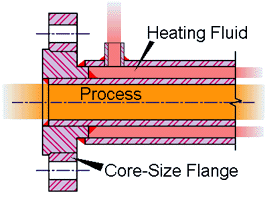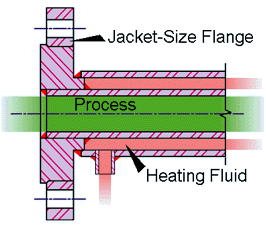Insert-Flanged jacketed piping features all the thermal benefits of standard jacketed piping while adding improved bolt-up flexibility. To accomplish this, an insert flange is utilized rather than a standard slip-on flange.

This flange is comprised of an insert (or hub) and a backing flange which is free to rotate on the insert to ensure bolt hole alignment during installation. The core and jacket pipes are welded to the insert in the same manner as in standard jacketed piping system.
There are two types of insert flanges: reducing and non-reducing.

Reducing insert flanges have the same size requirements as standard jacketed piping; the backing flange size matches the nominal size of the jacket pipe. This requires equipment that must mate with the reducing insert flange to have oversize flanges.
Non-reducing insert flanges are sized to match the core pipe and allow the use of core-sized equipment. In this regard, non-reducing insert-flanged jacketed piping is similar to swaged jacketed piping; but unlike swaged construction, non-reducing insert flanges enable back-of-flange heating for more uniform temperature control.
Due to its smaller size, the non-reducing insert flange demands more dexterity of installation personnel than does a reducing insert flange. For this reason, many designers specify reducing flanges on pipe-to-pipe connections and non-reducing flanges on pipe-to-equipment connections.
